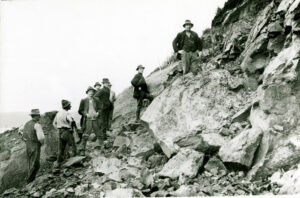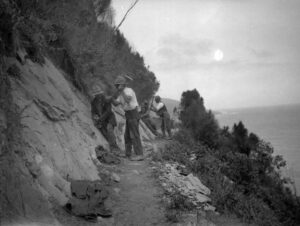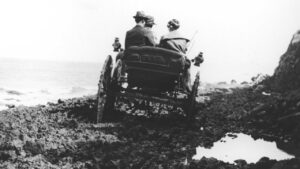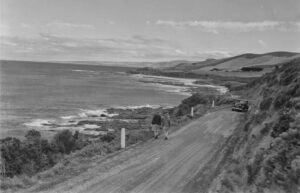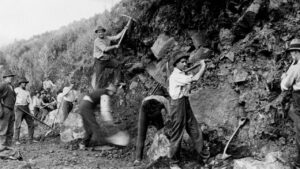The construction of the Great Ocean Road near Melbourne, Australia was an engineering feat that ended years of isolation for farmers and workers living along the coast.
Today the Great Ocean Road is a scenic coastal drive, the perfect place to explore on a day tour from Melbourne.
Making plans for a scenic coastal road
Before 1918 Victoria’s southern coast was accessible only by bush tracks, or by boat. There were small townships and large farming properties dotted along the coast, but it was difficult to bring people and supplies to and from these areas. It was either a rough boat ride at sea, or a bumpy drive along rough forest tracks.
At the end of World War 1, William Calder, Chairman of the Country Roads Board, requested that money be allocated for returned soldiers to work on roads in the regional areas of Victoria. And so began planning for what would become the ‘Great Ocean Road’.
The plan was to provide better road access to these isolated communities. However, it would also create a scenic drive that would attract tourists to the region. The project was also designed to create employment for the returned soldiers. They had come back to find scarce employment opportunities waiting for them.
Surveying began in 1918 for the Great Ocean Road (originally planned to be called the ‘South Coast Road’). It was a project that would take many years and a lot of hard work.
Building the road
On the 10th September 1919 construction began on the Great Ocean Road. During the 13 years it took to build the road, it is estimated that around 3000 returned servicemen participated in the construction.
Therefore, when the road was complete it was dedicated to the return soldiers who built it. As such, the Great Ocean Road today serves as a war memorial for the service men and women who had made the ultimate sacrifice in World War 1.
It is the longest war memorial in the world.
By today’s standards, construction of the Great Ocean Road was incredibly slow. But at the time, they were working with explosives, pick and shovel, wheelbarrows and small pieces of machinery. They managed to carve out about 3 kilometres of road per month.
In March 1922, the first stretch of the road from Eastern View to Lorne was completed. This called for a celebration! There was a parade along the road with locals and school children in Lorne waiting to greet the arriving cars.
Also in 1922, tolls were introduced to allow the Great Ocean Road committee to recover some of the expenses they incurred in building the road. The charge was two shillings per motor car, or 10 shillings for a wagon pulled by more than two horses.
In November 1932 the road was considered to be complete. It was a dirt road winding its way from Eastern View, via Lorne, to Apollo Bay. The road was officially opened during a celebration in Lorne and it was declared to be a war memorial.
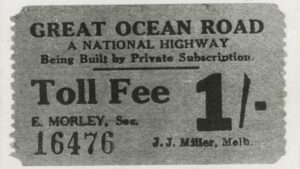
Aboriginal History of the Great Ocean Road region
The Great Ocean Road region is a place that has a strong and significant Aboriginal history. Long before the road was constructed, the area was home to clans related to the Gunditjmara, Wathaurong, Eastern Maar and Gadubanud language groups.
For tens of thousands of years the coastline and hinterland provided natural resources for these clans. It was an area rich in natural resources, providing opportunities for fishing, hunting and gathering.
Unfortunately, it was these resources which were also significant to Europeans immigrants. The farming and fishing undertaken by the early European settlers, came into conflict with the ways of the Aboriginal people.
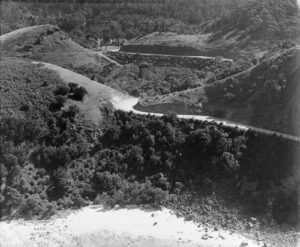
Touring the Great Ocean Road today
The Great Ocean Road today looks very different to the original road. It has been extended over the years to now start in the surf town of Torquay. It continues along the coast all the way to Peterborough.
Australia’s most iconic drive is a popular destination for tourists. The original plan was to not only provide better access to the towns along the coast, but to attract visitors to the area. These days hundreds of thousands of tourists make their way along the Great Ocean Road each year.
It is a popular summer holiday location for people living in Melbourne. In addition, it is the most popular day trip for visitors to take a day tour from Melbourne.
There’s many iconic locations to stop and take in along the Great Ocean Road. Bells Beach, home to a surfing contest that hosts the world’s best surfer each year. The cosy seaside towns that welcome you with fresh fish and chips, a hot coffee and locally made icecreams. You’ll leave with no doubt why Melburnians choose these destinations for their summer holidays.
There’s even a whole section of the coast dotted with lookouts – as each view becomes more spectacular than the next. From the steep steps of Gibson’s Beach to the mighty Twelve Apostles. Then on to the spectacular Loch Ard Gorge, named after a tragic shipwreck. All framed by towering limestone cliffs and a raging Southern Ocean.
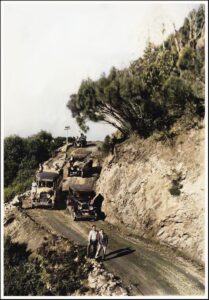
Australia’s involvement in World War 1
Australian’s became involved in the First World War when Britain and Germany went to war on 4 August 1914. The Australian Prime Minister at the time, Joseph Cook, and the Opposition Leader Andrew Fisher, pledged Australia’s full support for Britain. They were in the middle of an election campaign at the time. Australians greeted the news of their involvement in the war with great enthusiasm – as did many other people around the world.
There were many significant campaigns that Australian and New Zealand soldiers were involved in during the war. The combined armed forces of Australia and New Zealand were referred to as the ‘Diggers’ – a slang term that is still in use today.
However, the First World War was the costliest conflict that Australia has ever been involved with in terms of deaths and casualties. From a population of fewer than five million in 1918, 416,809 men enlisted. More than 60,000 were killed and 156,000 wounded, gassed, or taken prisoner.
To pay tribute to Australian and New Zealand servicemen and women, there are many war memorials throughout the country.
The Great Ocean Road Memorial Arch
Along the Great Ocean Road, the Memorial Arch was erected to pay tribute to Australia’s servicemen and women. From the Memorial Arch visitor area you can view the arch built over the road and the sign hanging from it. In addition, you’ll find a memorial statue acknowledging the returned soldiers who built the road. There are also other plaques and information boards detailing the road’s history.
Join us on a Great Ocean Road day tour from Melbourne to discover it for yourself!
Written by: Leah Furey – Digital Content Coordinator @ gowest.com.au

